Introduction
Theory of Operation
The mixer stage acts like two traditional direct conversion mixers operating in tandem. Each takes in half of the filtered RF from the bandpass filter stage and one of the quadrature center frequency signals, then "mixes" them to with an output being the traditional mixer products, in this case, two audio frequency signals that represent the difference between the two inputs (RF and Local Oscillator). These two signals are referred to as the I (in-phase) and Q (Quadrature) signals and are fed into the high gain Op-Amps stage for amplification and delivery to the audio outputs (and, thence, to the PC's sound card). The mixer is enabled when the RX_Mute line is grounded through Q4 (not shown here)
Schematic
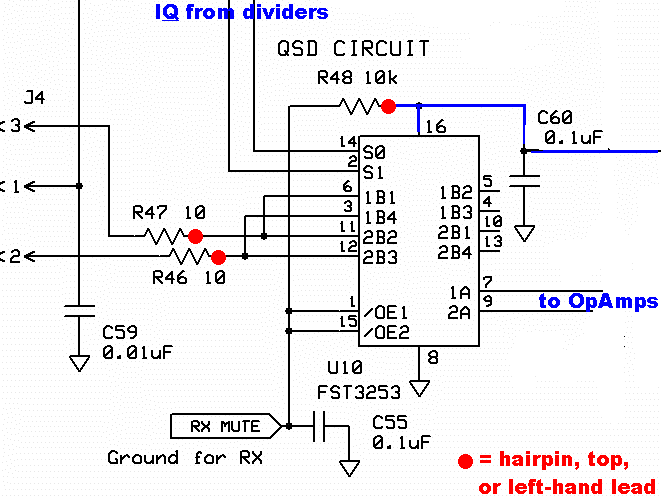
Summary Build Notes
- Install sockets J3 and J4
- Install Resistors R46-48
- Install U10
- Test the Stage
Bill of Materials
| Check | Designation | Component | (Color) Code | Type | Qty | Notes |
|---|---|---|---|---|---|---|
| [__] | J3 | 2-pin socket | connector (female) | 1 | ||
| [__] | J4 | 3-pin socket | connector (female) | 1 | ||
| [__] | R46 | 10 | brown-black-black-gold-brown | Resistor 1% | 1 | FlatH |
| [__] | R47 | 10 | brown-black-black-gold-brown | Resistor 1% | 1 | FlatH |
| [__] | R48 | 10 k | brown-black-black-red-brown | Resistor 1% | 1 | FlatV |
| [__] | U10 | FST3253 | SOIC-16 Dual 4:1 Mux/Demux Bus Switch | 1 | (bottom) |
Detailed Build Notes
Topside Components
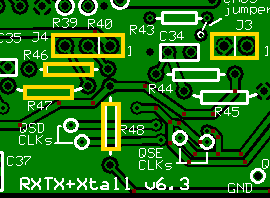
Install Sockets J3 and J4
Use the provided 9 pin header strip to align the sockets during installation. These sockets will be the points for mounting the Bandpass Filter (BPF) board.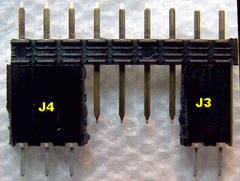
- Install J3 (2 pin socket)
- Install J4 (3 pin socket)
Install the 3 resistors
- Install resistors R46-R48 to the top side of the board (all are "flat" orientation)
| Check | Designation | Component | (Color) Code | Type | Qty | Notes |
|---|---|---|---|---|---|---|
| [__] | R46 | 10 | brown-black-black-gold-brown | Resistor 1% | 1 | FlatH |
| [__] | R47 | 10 | brown-black-black-gold-brown | Resistor 1% | 1 | FlatH |
| [__] | R48 | 10 k | brown-black-black-red-brown | Resistor 1% | 1 | FlatV |
Bottomside Components
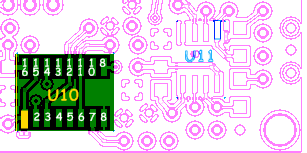
Install U10
Follow the guidelines for ESD precautions and SMT IC Installation.- Install U10, the FST3253 Switch (Mixer), to the bottom side of the board on the 14 SOIC pads provided.
- The IC is oriented such that when the dot/depression on the top is on the left hand side, pin 1 is at the bottom left (see table below).
| Check | Designation | Component | Orientation |
|---|---|---|---|
| U10 | FST3253MX SOIC-16 SMT Mixer |

|
Completed Boards
(pictures courtesy of Oleg Titov)Topside
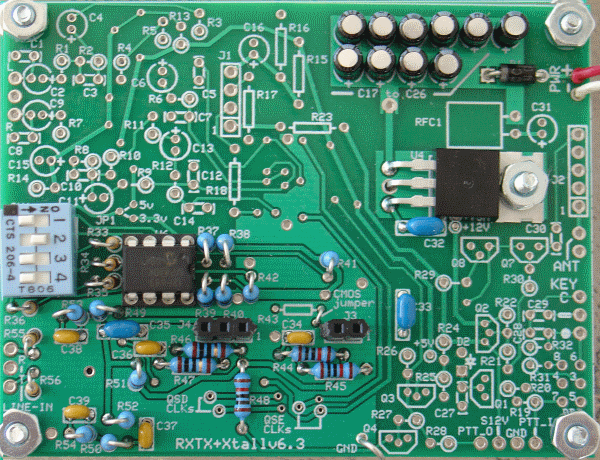
Bottomside
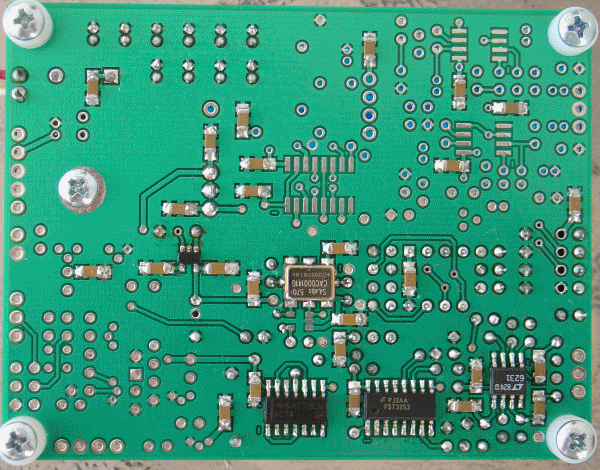
Testing
Note: these tests require you to have built and plugged in at least one bandpass filters.
If you have not yet done so, you can still conduct the current and voltage tests provided you short pins 1, 2, and 3 of J4 together to provide the DC equivalent of the T100 secondaries.
Current Limited Power Test
- Connect a 100 ohm resistor in series with the power line and apply 12 V dc power
- the current should be less than 120 mA (nominally 90 mA)
- Measure the voltage WRT ground at the +5 V and at the 3.3 Vdc testpoints.
- A voltage of around 2 V dc indicates the power rails are not shorted
- Remove the current-limiting resistor. Subsequent tests in this stage are with the current-limiting resistor OUT of the circuit.
Current Draw (DMM)
- Remember the 12-15 mA adjustment for the LVDS version.
- Then measure the current with your DVM's mA meter.
- The current draw should be < 98 mA (not appreciably different from the previous stage). The author measured 89 mA (not appreciably different from the previous stage).
- Your measurement: _________________________.
Pin Voltages (DMM - 0, 2.5, and 5 Vdc)

Measure U10 Pin Voltages

- Temporarily mount a shunt wire in the Q4 holes between the collector and the emitter, grounding the RX Mute lead and, thus, enabling the RX mixer.
- Using a DMM, measure the dc voltage (with respect to ground) of the pins of U10.
- It is best to test for these voltages at the actual pins (not the pads), thereby ensuring correct soldering of the pins to the pads.
| Test Point | Units | Nominal | Your Measurement | Circuit |
|---|---|---|---|---|
| U10, Pin 8 | Vdc | 0 | Mixer | |
| U10, Pin 16 | Vdc | 5V rail | Mixer | |
| U10, Pins 1&15 | Vdc | 0 - 50 mV | Mixer | |
| U10, Pin 2 (from divider) | Vdc | ½ 5V rail | Mixer | |
| U10, Pin 14 (from divider) | Vdc | ½ 5V rail | Mixer | |
| U10, Pin 7 (to OpAmp) | Vdc | ½ 5V rail | Mixer | |
| U10, Pin 9 (to OpAmp) | Vdc | ½ 5V rail | Mixer |
If the voltage at pins 1 and 15 is not in the area of 0 - 50 mV, then the mixer will not be enabled and there will be no outputs at pins 7 and 9.
The voltages at pins 3, 6, 11, and 12 will vary fairly widely, depending upon the balance of the QSD clock signals from the divider. The closer they are to being in balance, the closer will be these pins' voltages to ½ the 5 V rail voltage. This variation is more pronounced for the higher frequency SW1 settings.
RX Test in Rocky
An additional test is to run Rocky, feeding the Ring and Tip outputs to the Line In inputs of your PC's sound card.
This test requires you to have completed the 80/40m BPF board. If you have not yet done so, go to that stage and then return to this test.
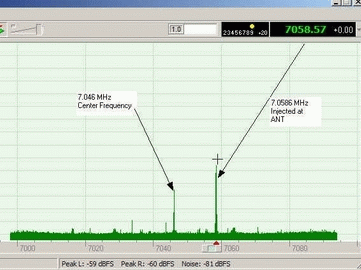
- If you already have not done so, download and install Rocky
- Run Rocky and click on the
View > Settingsmenu - In the "settings" menu, click on the "DSP" tab
- in the "DSP" tab's "Local Oscillator" section, click on the button marked "Single Band" and type in the desired center frequency (7046000). This sets Rocky's center frequency at 7.046 MHz.
- Click on the "Audio" Tab and select your sound card (if it is not already selected) in the "I/Q Input Device" dropdown box.
- Click on OK to close the "Settings" Menu
- Tack solder the audio cable to the board's "Line In" connections and plug the audio cable into your sound card's Line-In input
- Plug the 80/40m BPF board into jacks J3 and J4
- With RF signal (e.g. 7.059 MHz) injected at the Pin P100-1 of the BPF board, power up the board
and click the
File > Start Radiomenu choice. - You should see the Rocky spectrum display resembling the image on the right.
- If your signal source can sweep the frequency, observe Rocky's spectrum display as the generator sweeps through the "chunk" of bandwidth centered on the center frequency.